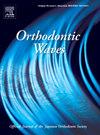特立尼达和多巴哥双颌突出的头测量标准:初步研究
IF 0.5
Q4 DENTISTRY, ORAL SURGERY & MEDICINE
引用次数: 1
摘要
摘要:本研究的目的是首次建立特立尼达和多巴哥人群双颌前突的头颅测量标准,并将研究结果与先前发表的其他双颌前突人群的标准进行比较。材料与方法在接受正畸治疗前,由一名研究者拍摄了109张标准化侧位头颅x线片。样本包括52名男孩和57名女孩,年龄在10-17岁之间。使用48个硬软组织和25个线性和角状头颅测量来追踪脑电图。采用独立样本t检验评估性别间差异,计算规范值。然后将结果与其他双颌突出人群的标准进行比较。结果获得的平均值和标准差为:SNA为85.9°(±4.9°);Snb, 78.7°(±4.5°);Anb, 7.2°(±2.5°);MMPA 32.3°(±5.1°);UI-LI 109.7°(±8.2°);UI-Max, 118.7°(±6.1°);LI-Man, 101.4°(±5.9°);LI-Apo, 3.8°(±2.6°);上唇距e面2.0 mm(±3),下唇距e面5.6 mm(±3.2)。独立t检验显示,男性的SNA和上下唇与e平面的性别二态性高于女性。与高加索人相比,这个样本的上颌骨和下颌骨位置更靠前。ANB、MMPA、UI-Max、LI-Man、LI-Apo、上唇和下唇至e平面均高于其他双颌前突人群。结论特立尼达和多巴哥地区双颌前突人群的头颅测量标准存在一些根本差异,在正畸诊断和治疗计划中应以这些头颅测量标准为衡量标准。本文章由计算机程序翻译,如有差异,请以英文原文为准。
Cephalometric norms for Bimaxillary Protrusion in Trinidad and Tobago: a preliminary study
ABSTRACT Abstract The aim of this study is to establish for the first time cephalometric norms for bimaxillary protrusion in Trinidad and Tobago population and to compare findings to previously published norms for other bimaxillary protrusion groups. Materials and Methods In total, 109 standardized lateral cephalometric radiographs were taken by one investigator of bimaxillary protrusion patients prior to receiving orthodontic treatment. The sample consisted of 52 boys and 57 girls aged 10–17 years. The cephalograms were traced using 48 hard and soft tissue and 25 linear and angular cephalometric measurements. Independent sample t-test was used to assess inter-gender differences, norms were calculated. The results were then compared to the norms for other bimaxillary protrusion populations. Results The mean values and standard deviations obtained were: SNA, 85.9° (± 4.9°); SNB, 78.7°(± 4.5°); ANB, 7.2°(± 2.5°); MMPA, 32.3°(±5.1°); UI-LI,109.7° (±8.2°); UI-Max, 118.7° (±6.1°); LI-Man, 101.4° (±5.9°); LI-Apo, 3.8° (±2.6°); Upper lip to E-plane 2.0 mm (±3) and Lower Lip to E-plane 5.6 mm (±3.2).The independent t-test showed sexual dimorphism with SNA and upper and lower lip to E-plane being higher in males compared to females. The maxilla and mandible were more anteriorly placed in this sample as compared to Caucasian norms. ANB, MMPA, UI-Max, LI-Man, LI-Apo, upper lip and lower lip to E-plane, were all higher in this population compared to other bimaxillary protrusion populations. Conclusions There are some fundamental differences in the cephalometric norms for the bimaxillary protrusion population in Trinidad and Tobago and in the context of orthodontic diagnosis and treatment planning these cephalometric norms should be the yardstick.
求助全文
通过发布文献求助,成功后即可免费获取论文全文。
去求助
来源期刊

Orthodontic Waves
DENTISTRY, ORAL SURGERY & MEDICINE-
CiteScore
0.40
自引率
0.00%
发文量
0
期刊介绍:
Orthodontic Waves is the official publication of the Japanese Orthodontic Society. The aim of this journal is to foster the advancement of orthodontic research and practice. The journal seeks to publish original articles (i) definitive reports of wide interest to the orthodontic community, (ii) Case Reports and (iii) Short Communications. Research papers stand on the scientific basis of orthodontics. Clinical topics covered include all techniques and approaches to treatment planning. All submissions are subject to peer review.
 求助内容:
求助内容: 应助结果提醒方式:
应助结果提醒方式:


